Are you thinking about Free-ranging your animals? It’s a great idea – but check out these tips for Free-ranging (and my practical advice!) before you do so.
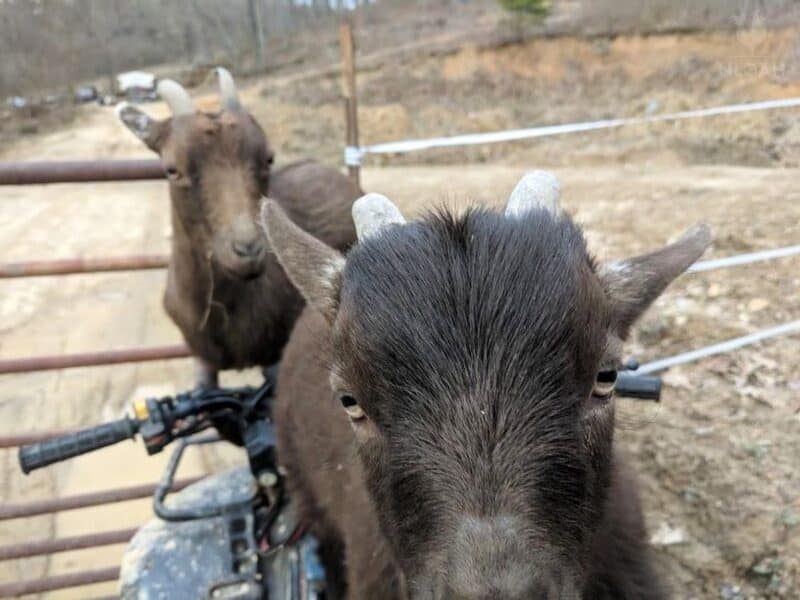
For most people, the idea of letting their animals roam freely sounds like a dream come true – you don’t have to feed them anymore (or at least not quite as much) which means saving money right off the bat!
I have always been a huge believer in free-ranging my livestock. It is an old-fashioned technique that has proven to be very successful for centuries. I have seen the benefits of this many times over with both chickens and goats, but it’s not without its risks.
Read on below to learn more about the pros and cons of free-range farming, as well as some tips for getting started!
What is Free-Ranging?
Free-ranging is a term that refers to animals that have access to outdoor spaces, in the most technical sense of the phrase. When thought of in a more specific sense, it is a method of raising animals in which they are free to go where they please. around the homestead
Free-range animals might spend all of their time exclusively outdoors or just a small portion of their time outside. It’s really up to you to decide how much you allow your animals to free-range (and where you allow them to go).
Benefits of Free-Ranging
In my list of practical tips for free-ranging below, I’ll address some of the major challenges associated with the free-range model of farming.
But before I talk about any negatives, let’s first discuss the benefits – there are many!
✅ Happier, Healthier Animals
Chances are, if you’re interested in free-ranging your animals, it’s for their own well-being. Free-ranged animals tend to be much happier and healthier since they can forage for their own food and roam about freely. They’ll have the freedom to do exactly what they’d like, helping to keep them happier and ultimately, healthier.
Free-ranged animals, be it chickens, goats, pigs, or any other kind of critters, tend to be less likely to succumb to diseases related to confinement. These include viral and bacterial diseases as well as internal parasites.
That means less time spent deworming and administering medication, less time cleaning and maintaining barns, and fewer visits to the vet.
Animals know what’s good for them! They’ll eat the foods that are most nutritious for them and ideally, none of the bad stuff you don’t want them getting into.
✅ Happier, Healthier You
Animals that are allowed to free-range produce much healthier milk, meat, and eggs. No matter what it is that you are trying to produce on your farm, you’ll find that the meat is leaner and the nutritional content higher when your animals are allowed to roam freely.
✅ Fewer Insect Problems
Chickens in particular are known for their ability to cut down on the number of ticks, mosquitoes, and other pests you don’t want on your property. However, it isn’t just chickens that offer this kind of benefit.
Ducks, geese, guineas, and many other kinds of animals can help reduce the number of pests on your lawn and in your garden.
✅ Weed Eating
Have a ton of weeds around your fences that you need cleared – but don’t want to use dangerous herbicides to get rid of them? Free-ranging livestock to the rescue! Allow your animals to free-range and they’ll take care of all those weeds you want gone – and in a hurry.
✅ Better Production
Free-ranged animals tend to produce better than those that are raised in confinement. Whether it’s milk, meat, or eggs that you are after, free-range animals will be much more productive. Better for you!
✅ Saves Money
Last but not least, allowing your animals to free-range can also save you money. When your animals are even just partially free-range, you’ll be able to save a ton of money on animal feed – after all, you don’t have to worry about buying expensive feeds since everything is provided by Mother Nature herself.
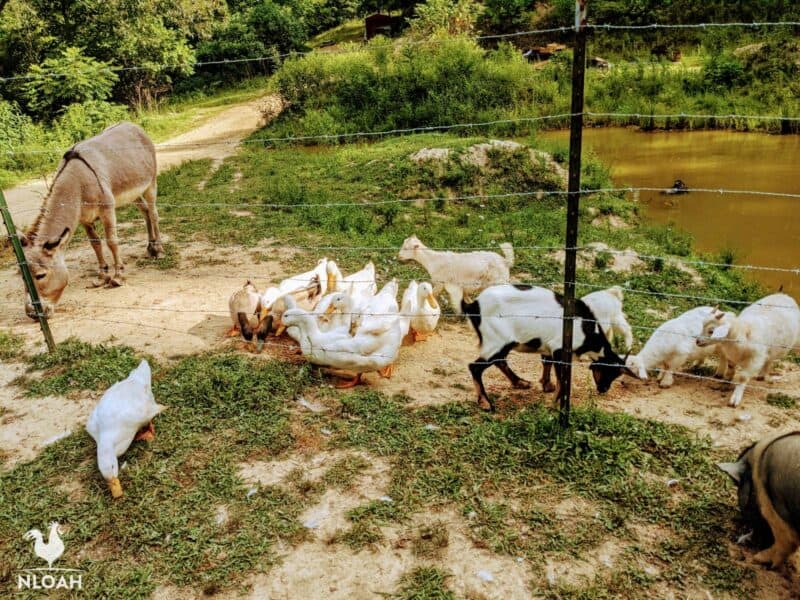
13 Practical Tips for Free-ranging Any Animal
No matter what kind of animal it is you are Free-ranging, these tips should help you get started – and we’ll give you more practical tips for each species below, too.
✅ You’ve Really Got to Supervise
Allowing your animals to free-range isn’t unlike raising a toddler. No matter how old your livestock are and how used to each other you are, it’s important that you keep a close eye on free-ranging animals, particularly in the early stages of things.
You never know when an errant chicken might wander into the neighbor’s flower garden – and that’s definitely going to cause issues. You’ll also need to supervise your animals more closely if you live close to the road. This can have some implications not only for their own safety but also can pose some liability concerns if a larger animal is struck by a vehicle.
✅ Watch the Garden
It doesn’t matter what kind of livestock you are allowing to free-range on your property – chances are, they’d all love the opportunity to nibble on your garden plants. Don’t let them!
Whether it’s chickens, rabbits, goats, or sheep that you are allowing to roam, make sure your garden is protected.
Fences work well but make sure the fence you erect around your garden is well-suited to the type of livestock you are allowing to free-range (a three-strand electric fence, for instance, probably isn’t going to keep out a chicken).
✅ Things Can Get… Dusty
…and muddy, too, in a hurry. While chickens are the biggest culprits when it comes to stirring up dust (they’ll scratch the grass away to get to the dusty dirt so they can create their own dust baths, leaving a dusty mess in their wake), other animals will also turn up the soil when given the opportunity.
Have you ever seen the kind of mess a pig can make?! If you are concerned about this, unlimited Free-ranging might not be for you.
✅ Some Shelter is Still Essential
It doesn’t matter what kind of livestock you raise – you can’t totally eschew shelter. I suppose you can, I guess, but I wouldn’t recommend it.
Smaller livestock need some protection from predators (even ones that are slightly larger, like sheep and goats, still benefit from protection from coyotes and wolves). Shelter is also beneficial in extreme weather conditions, like intense heat, driving snow and rain, or cold. Even if the shelter you offer your animals is just a three-sided shack, make sure they have a place to go for refuge.
✅ Mind the Manure
One of the biggest issues with allowing your animals to free-range is all the poop they produce. When you raise your animals inside pre-established paddocks, you don’t have to worry quite as much about the poop because it all stays in one place.
Allow your animals to free-range and you’ll have manure everywhere, including on your deck, on your patio chairs, in your swimming pool, and even on your car. Consider this before you allow unfettered free-ranging and consider fencing off areas you don’t want to find an errant piece of poop!
✅ Predation Can Be an Issue
As I mentioned earlier, predation can be a major issue when allowing your animals to free-range. Even if you go to great pains to lock them up at night, there are plenty of predators (like neighborhood cats and dogs) that will enjoy the all-you-can-eat buffet presented by your free-ranging critters.
You may find that being more vigilant only goes so far – you might have to limit frree-ranging to just when you are at home and can constantly supervise your animals if you want to avoid unintended losses to predators.
✅ Try Mobile Animal Housing Instead of Full Free-ranging
If the last point has you second-guessing your desire to free-range your animals, let me present to you one more option. Instead of full free-ranging, you might consider using mobile animal housing instead.
An example of this is a chicken tractor. Chicken tractors are meant to be moved every day so that your animals can have access to fresh pasture. The poop doesn’t accumulate as much since they are moved so frequently and they are always able to stretch their legs and nibble on tasty morsels that they find.
At the same time, though, you don’t have to worry about predators, about poop where you don’t want it to be, or about animals getting into your gardens or flower beds. It’s really a win-win!
✅ Don’t Forget to Keep Clean Water Available
Even if you think your animals are finding all the food they need and want in the wild, it’s still a good idea to put out waterers. Water can be tougher to find than food for many animals, so make sure you have a few watering stations set up around the property if you plan on exclusively free-ranging your livestock.
✅ Get Them Used to Home Base
Even if you want your animals to be able to roam freely, it’s a good idea for them to have an established spot to come home to at night. Before you let your animals free-range, lock them up in the barn, coop, or other shelter you’ve built so that they can get used to it. Keeping them inside for a few days to a few weeks will teach them that this is home – and they’ll come back to sleep or roost. You can offer treats to encourage them to come home for the first few nights, too.
✅ Try Tying Larger Animals Up
Sometimes, exclusive free-ranging just doesn’t work well for larger animals (goats, sheep, and cows come to mind).
In that case, you might consider taking your animal to a spot in the front yard. You can move the stake around to the area where you want the goat to be. Make sure the rope is nice and long so your animal won’t get frustrated but not so long that he can get tangled. I recommend only trying this method if you can be home to supervise – otherwise, you might end up with injured animals.
✅ Keep Dogs Close (or Not)
Another option to help keep your animals safe from predators while they are free-ranging is to consider using livestock guardian animals.
Livestock guardian dogs are great, when properly trained, at protecting goats, sheep, and even chickens. You’ll need to purchase an animal with the right genetics and training, though, or this method can actually backfire – your dog might view the animal as a tasty snack.
✅ Know How Much Land You Need
Take the time to carefully plan out your free-ranging efforts before you let your animals loose. Know how much space is needed per animal (the average goat, for example, needs about an acre of land if the land is poor). You don’t want to overcrowd things.
Free-Ranging Chickens and Ducks
Chickens are some of the easiest animals to free-range, which is why they are probably the first to come to mind when you consider raising your livestock in this fashion.
In fact, many backyard chicken keepers and homesteaders choose to allow their chickens to free-range for a majority of the day.
You’ll want to keep the above tips in mind along with one other thing – their eggs.
If allowed to exclusively free-range without first being trained to lay their eggs in a nesting box in a coop, then guess what? You’re going to have a really hard time finding your chicken’s eggs when they lay them. Because of this, you may want to train them to the coop or keep them in the coop at least part of the day (preferably at night) so they know where to lay.
Speaking of locking chickens up, make sure you have some sort of shelter for them at night. Of all the animals that you might have free-range, chickens are without a doubt the most vulnerable to predators.
Therefore, you’ll want to make sure you put your chickens to bed each night and that their shelter is secure from all kinds of predators (including aerial predators like owls and hawks). Nighttime is not a good time to allow chickens to do their thing and roam freely!
The same advice listed above also applies to ducks. You can even allow your chickens and ducks to free-range together, if you like. Ducks aren’t as likely to damage grass, either, so they may be a safer bet when it comes to free-ranging for many people.
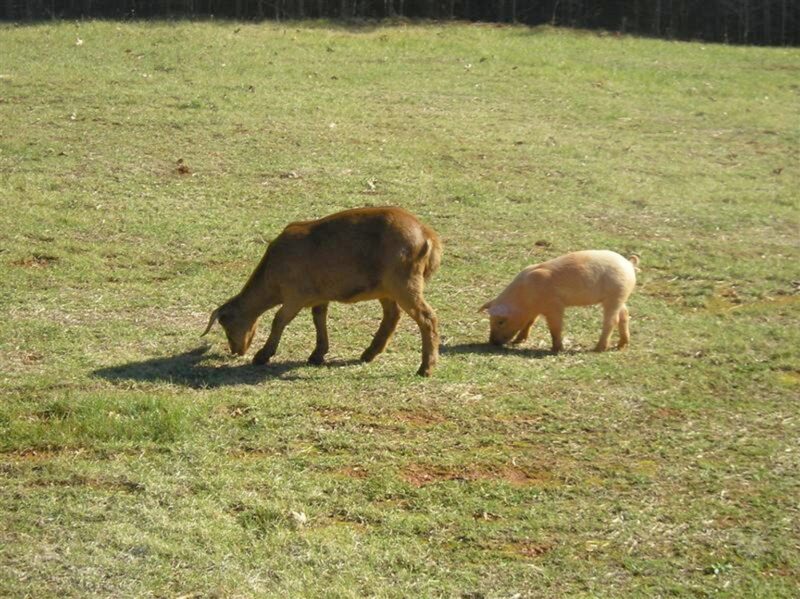
Free-Ranging Goats and Sheep
Many people don’t realize this but Free-ranging goats is definitely a possibility. I recommend fencing off any sensitive vegetation that you don’t want nibbled on – true to their reputation, goats will eat just about anything!
They require a fair bit of space, generally up to half an acre each, but if you allow them to free-range, you’ll only need about ten feet of indoor space per goat.
Goats are a bit sensitive in that they need a routine in order to feel safe. Even if you allow your goats to free-range, it’s a good idea to feed and water at the same time each day.
When allowing goats to free-range, make sure they aren’t going it alone. Goats get lonely easily and having a friend to wander around with will help keep them out of trouble (and prevent them from bleeding and crying all night long, too).
Finally, when free-ranging goats, keep in mind that while a goat will eat just about anything you want to get rid of (including poison ivy, weeds, and more) you do still need to provide a bit of grain – about 10% of a goat’s diet should consist of grain.
I only recommend Free-ranging goats and sheep if you just have a few and perhaps if you can purchase a livestock guardian dog to keep an eye on your animals.
Like goats, sheep will get into just about any kind of vegetation, so make sure your garden is fenced off. They are just as vulnerable to predation so be sure to have systems in place to protect them.
Even if you let them free-range your entire property, I recommend erecting a large perimeter fence to prevent them from wandering into the road or onto a neighbor’s property.
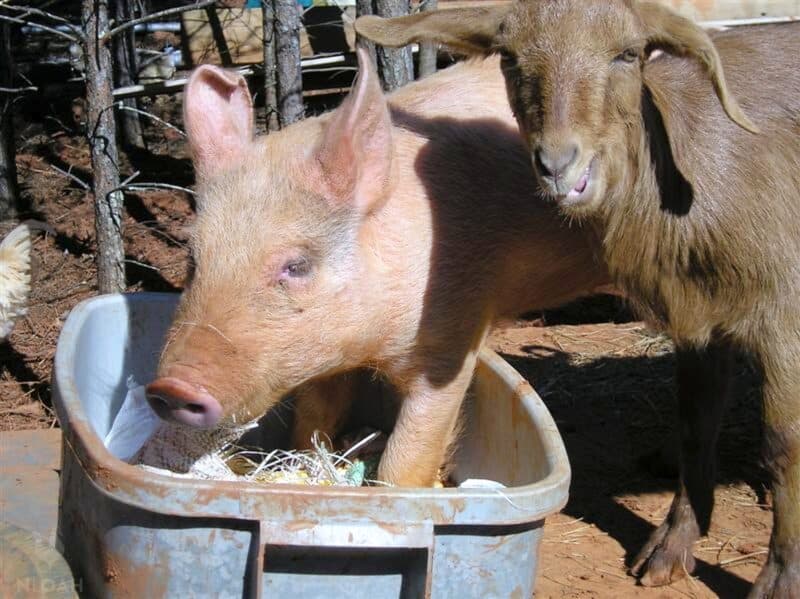
Free-Ranging Pigs
By far, free-ranging pigs is the least likely type of Free-ranging you will find.
That’s because pigs can be incredibly destructive. They will get into just about anything – including areas you don’t want them to roam.
Make sure you only allow friendly pigs to free-range – these animals can be aggressive and you don’t want them threatening the mailman! You will definitely want to fence off your garden and only free-range pigs if you have multiple to raise together. Otherwise, a single pig will get lonely and will consequently be more destructive.
As with sheep and goats, it’s a good idea to have a sturdy perimeter fence so your pigs don’t end up in the road.
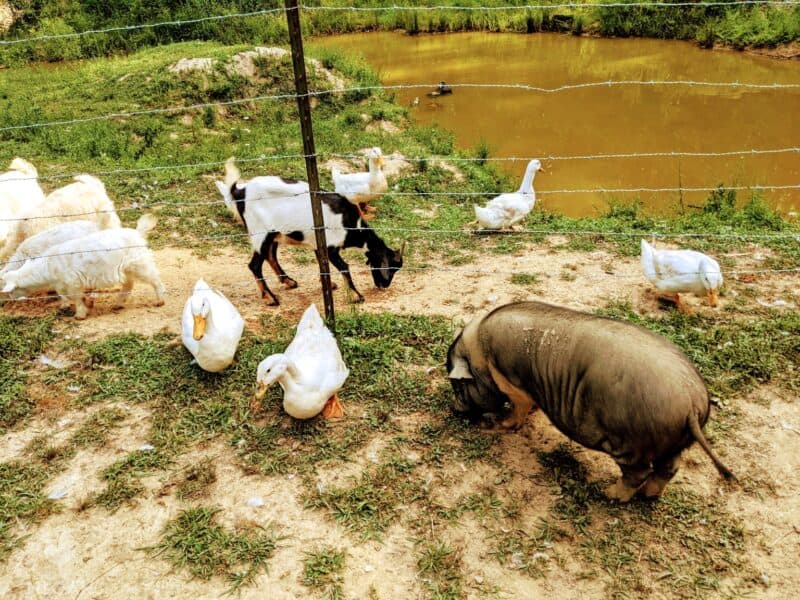
Free-Ranging Multiple Types of Animals Together (Multi-Species Grazing)
Do you have several of the types of animals listed above? If so, you don’t have to limit yourself to free-ranging with just one species. Instead, you can get the whole crew involved!
Multi-species grazing is a process in which a multitude of animals graze the same paddock. When used in the free-ranging model, they’d be allowed to roam where they please – but together.
This works well for just about any species of animal, but you do need to keep in mind certain things.
For example, pigs have been known to be aggressive toward other animals (particularly chickens, whom they might eat). While a friendly pig might leave your chickens alone, that might not always be the case.
If you’re providing any kind of grain or mineral supplementation to your animals (the latter of which is recommended for laying hens – calcium – and sheep and goats) you will need to make sure you have a way to keep the animals out of the other species’ food and minerals.
Some, like shape, are extremely sensitive to certain minerals (sheep can’t have a ton of copper). If they happen to get into your goat’s mineral supplement, this can have dangerous side effects.
If you plan on raising multiple animals together in the free-range style, make sure your exterior fences are strong enough to hold the wiliest of the animals. If you raise chickens and goats, for example, you will want a super-strong fence, since goats are quite adept at getting out of a pen. If you raise sheep and chickens, make sure it can hold the sheep, and so on and so forth.
Free-ranging multiple different species together has its benefits, though, particularly in terms of your animals’ health.
Most parasites, for example, are species-specific, and by grazing different areas of your land, it will not only improve the health of the plants that are growing but can also cut down on parasite load (since the animals will essentially “eat” each other’s parasites with no ill effects as a result of doing so).
Free-Ranging: What to Keep in Mind
Free ranging is wonderful. It feels good to let the animals out into the fresh air. It makes them happy, and your feed bill is dramatically reduced. I am all for free ranging all of our animals. But there comes a point when free ranging is just pure craziness!
This… this is okay. No harm done, right? (Well, as long as my mother-in-law doesn’t mind a goat on her truck!)
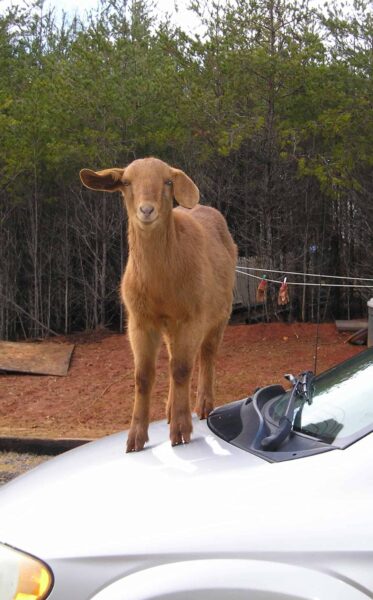
But remember this? Totally not okay! Get off the van! By the way, she climbs to the very top and naps up there too. Booger.
But it gets worse.
My front and back door are filthy from muddy hoof prints.
The beautiful wreath I had decorating my front door has become lunch to the goats on several occasions.
The chickens are scratching in, and destroying the nice mound of mulch around my baby fruit trees.
The pig has decided that her favorite potty spot just so happens to be immediately beside my back door steps- our main entrance. Great. Not exactly an inviting aroma.
And then there’s the clothesline…
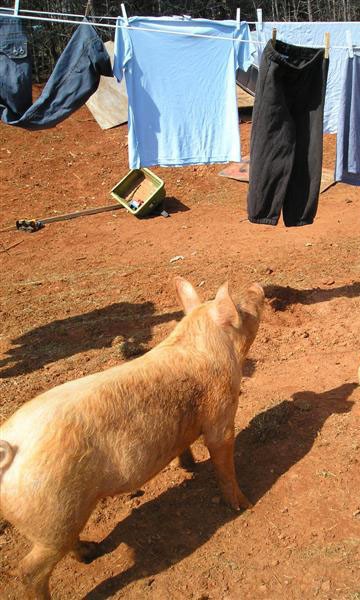
Not only does the puppy yank my clean clothes off the line and drag them into the dirt below…
The pig also thinks it’s a fun game to jerk my pants down and shake them violently in her mouth while I chase her around the yard trying to retrieve the now filthy garment. Even the goats get in on the action, assuming that I’m simply hanging up a yummy treat for them to nibble.
At times, it’s the picture of chaos.
Oh yeah, and try running to the car from a muddy pig on Sunday morning while wearing your best skirt and high heels. Fun, let me tell ya!
For heaven’s sake, if you’re gonna free-range your animals, keep them fenced in their own area! Make life easier on yourself and designate an “animal free” zone. Just one more thing I wish we’d done before we got the animals!
Apply the tips I’ve given you above in the ways that make the most sense for you and the specific type of animals you are trying to free-range. Whether you have five chickens or a dozen pigs, Free-ranging can be an effective way to increase your farm production and lower your costs – you’ll just need to make some specific adjustments.
Give Free-ranging a try today – but maybe not all at once, like me. Moderation is key, folks!
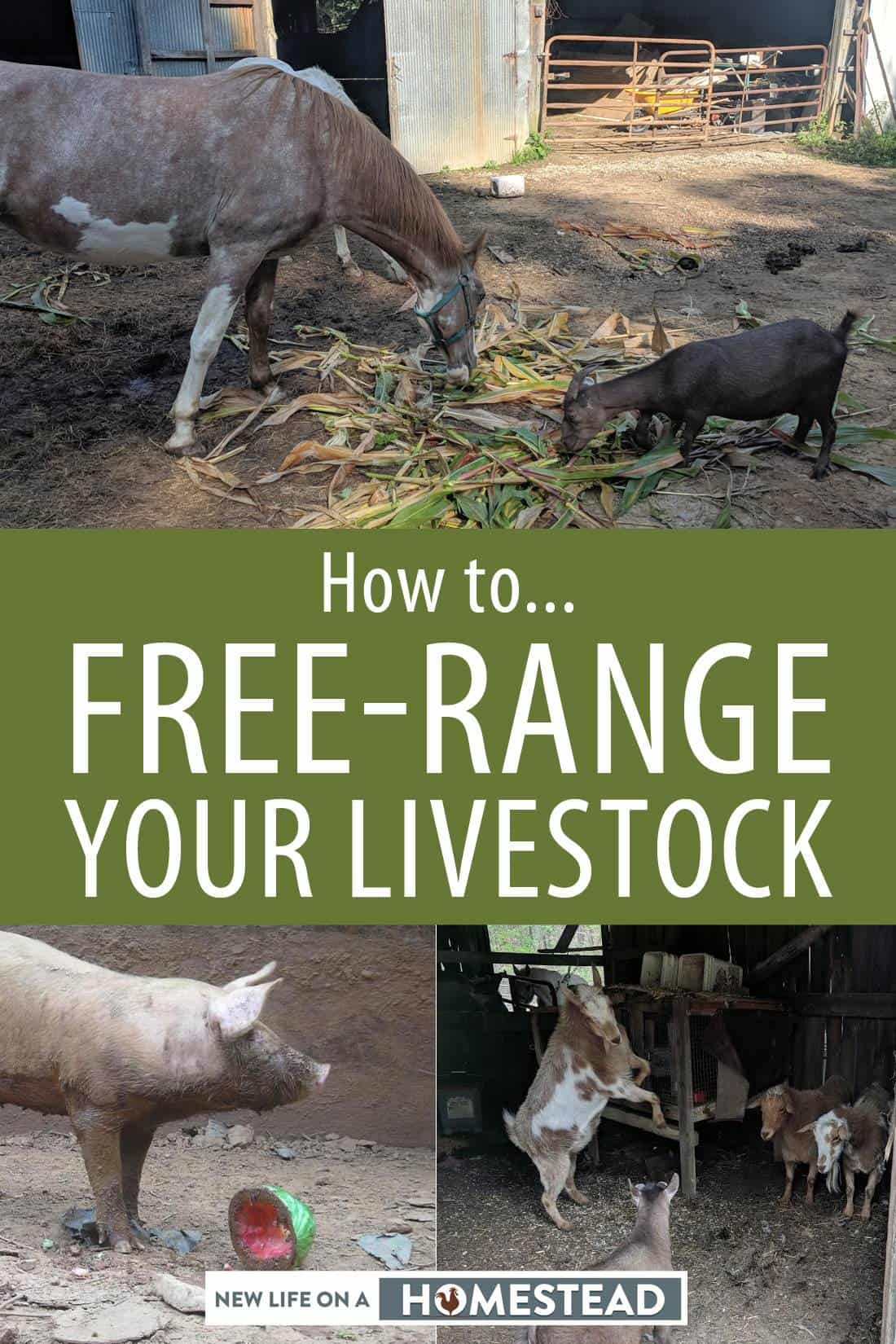

A city girl learning to homestead on an acre of land in the country. Wife and homeschooling mother of four. Enjoying life, and everything that has to do with self sufficient living.

I’m almost twice your age, but can still relate. I always knew growing up I wanted to live on a farm, but it can be something else sometimes. Our guinea rooster thought the reflection on our black Volvo wagon was another rooster he had to put in his place (ie be the Alpha male). I don’t know how long he was fighting his ‘competion,’ but needless to say, the car wasn’t a mirror reflection anymore. He flogged it pretty good. Our free-range turkeys love to roost on top of the car and that makes for scratches, as they try to get up past the incline on the hood. The baby goats love it when, just like the lady above said, they find they’re big enough to play ‘king of the hill’ on the roof of the car. They lose free-range privileges for bad behavior at that point. Back to the barn lot. Our neighbors have had quite a scare, when they turn around to a grunting sound behind them and find a 700 lb. black boar hog behind them in their back yard! How many times have we met the traffic that comes up & down our road when the goats figure out how to unlock the new lock on the fence and the whole herd of sheep discover the wonderful grazing beside the road! The adventures never end! (It’s usually the goats up to something, though.) Just always make sure the door is shut tight when you head out for Sunday school, you don’t want to see the mess the free-range layers make when the door blows open your house while your gone to church for hours on Sunday. 😉 At least the bedroom door was closed!
Glad to see you’re enjoying yourself.
Heather-
Oh my goodness!! LOL, that’s hilarious! Sounds like you’ve had your fair share of free range mishaps 🙂 Thanks for the laugh!
I think some sort of limited free range is not too traumatizing! Especially if your house is taking a beating from the chaos! Here’s hoping you are able to find the balance! I can’t have free range animals, my dog would eat them and I live in town. Sucks but I think after seeing this post when we are able to move and get some animals I will put some sort of enclosure up. Thanks for letting us learn threw you. I know your thinking “yeah well great I’m so glad to be of service to you” LOL! I love your blog! Still uncertain about the pig thing but to each it’s own!
Just found your blog while looking for info on potato planting and I’ve bookmarked you. Love your honesty and humor. And your name!
LOL! Love your name too! It’s becoming more and more common, isn’t it? 🙂
This reminds me of when my dad thought it was a good idea to get me a Billy Goat for a pet at the age of 5 to teach my responsibility. He soon realized I was learning to not be trampled by this aggressive bearded animal. They are much more agile than people thing! LOL
Oh can I sympathize! We had goats, once. We had just enough of a crack between the gate and the fence post that they could squeeze out. And, boy what fun they had playing king of the hill on top of my car!
My kids thought it was hysterical, the insurance company not so much.
I can relate to this also. We just made our “animal free zone” and I’m surprised how much time I have now that I’m not constantly peering out the window to see what they will do next. I didn’t realize how stressful this actually was.
This is just hilarious!!! I can totally visualize it and can only imagine, having not ventured into owning animals (other than our dogs!) yet, what chaos it brings. But I gotta admit- the sight of your goat on the van is just SO FUNNY!
Oh, the van! I’d be crying! My mom had goats that use to climb the trees! Seriously. And our chickens wrecked my pot plants in the back before I got wise and limited the “free range” just a bit. Now we are all happy at the Homestead again. I haven’t gotten our own goats yet because I’m taking your advice and waiting until I can get the proper shelter and fencing in place.
Amy- you are a wise woman 🙂
You just continue to make me laugh. I am so glad you are still online.
thanks again for the chuckle.
Oh yes – I can relate. Our bobby calf that grew up used to jump the fence & try & eat the clothes off our washing line. My chickens have scratched up over half of the seedlings in my greenhouse – hmmm many times I thought about not free ranging them, but I know it’s so much healthier for them.
Hope you have a good day
Renata 🙂
I love the pictures!